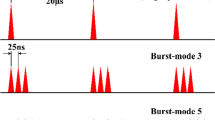Abstract
Pulsed ytterbium-doped fibre lasers based on a master oscillator power amplifier (MOPA) architecture possess attractive characteristics over their Q-switched diode-pumped solid-state counterparts. These include a relatively low cost of ownership and a flexible operating window with respect to the pulse duration, shape and repetition rate. For micro machining applications, given this inherent large processing window available with respect to the pulse characteristics, the effect of process parameters on particular machining outcomes needs to be investigated systematically. In this context, this paper considers the effect of a number of factors on the achievable material removal rate and surface roughness when processing aluminium with such fibre laser system operating at 1,064-nm wavelength and having built-in capabilities for selecting the duration of the delivered pulses in the nanosecond regime. The process parameters under investigation in this study were the pulse duration and repetition frequency, the pulse overlap, the scanning strategy and the distance between linear machined tracks. Initial results showed that, for pulse durations comprised between 25 and 140 ns, the specific frequency at which both the highest energy and average power are delivered leads to the maximum material removal rate (MRR) achievable and to high values of surface roughness. Following this, a design of experiments was conducted for a given pulse length with the aim of identifying an optimum combination of parameters with respect to the attained surface finish while operating at the frequency resulting in the highest MRR. This optimisation study resulted in a 60-% decrease in the achieved surface roughness and also showed that the distance between machined tracks had the highest influence on the surface finish.
Similar content being viewed by others
References
Bruening S, Hennig G, Eifel S, Gillner A (2011) Ultrafast scan techniques for 3D-μm structuring of metal surfaces with high repetitive ps-laser pulses. Phys Procedia 12(2):105–115
Zimmer K, Braun A, Bigl F (2000) Combination of different processing methods for the fabrication of 3D polymer structures by excimer laser machining. Appl Surf Sci 154–155:601–604
Wang XD, Michalowski A, Walter D, Sommer S, Kraus M, Liu JS, Dausinger F (2009) Laser drilling of stainless steel with nanosecond double-pulse. Optics Laser Technol 41(2):148–153
Lee S, Yang D, Nikumb S (2008) Femtosecond laser micromilling of Si wafers. Appl Surf Sci 254(10):2996–3005
Gabzdyl J (2008) Materials processing: fibre lasers make their mark. Nat Photonics 2:21–23
Petkov PV, Dimov SS, Minev RM, Pham DT (2008) Laser milling: pulse duration effects on surface integrity. Proc Inst Mech Eng B J Eng Manuf 222:35–45
Yasa E, Kruth J-P (2010) Investigation of laser and process parameters for selective laser erosion. Precis Eng 34(1):101–112
Gounaris E, Casioppo D, Denney P (2010) Mixed mode ablation used for improvements in laser machining. Proceedings of the 29th International Congress on Applications of Lasers & Electro-optics (ICALEO2010), California, USA
Voisey KT, Kudesia SS, Rodden WSO, Hand DP, Jones JDC, Clyne TW (2003) Melt ejection during laser drilling of metals. Mater Sci Eng A 356(1–2):414–424
Deladurantaye P, Gay D, Cournoyer A, Roy V, Labranche B, Levesque M, Taillon Y (2009) Material micromachining using a pulse fiber laser platform with fine temporal pulse shaping capability. Proceedings of SPIE, 7195, article id. 71951S, 12 pp
Herfurth H, Patwa R, Lauterborn T, Heinemann S, Pantsar H (2007) Micromachining with tailored nanosecond pulses. Proceedings of SPIE, 6796, article id. 67961G, 8 pp
Liu YH, Hu JD, Zhao L, Guo ZX, Chumakov AN, Bosak NA (2010) Accumulation morphology on the surface of stainless steel irradiated by a nanosecond Nd:YAG pulsed laser. Optics Laser Technol 42(4):647–652
Leone C, Genna S, Caprino G, De Iorio I (2010) AISI 304 stainless steel marking by a Q-switched diode pumped Nd:YAG laser. J Mater Process Technol 210(10):1297–1303
Bartolo P, Vasco J, Silva B, Galo C (2006) Laser micromachining for mould manufacturing: I. The influence of operating parameters. Assem Autom 26(3):227–234
Selada A, Manaia A, Vieira MT, Pouzada AS (2011) Effect of LBM and large-area EBM finishing on micro-injection moulding surfaces. Int J Adv Manuf Technol 52(1–4):171–182
Campanelli SL, Ludovico AD, Bonserio C, Cavalluzzi P, Cinquepalmi M (2007) Experimental analysis of the laser milling process parameters. J Mater Process Technol 191(1–3):220–223
Roy R (2010) A primer on the Taguchi method. 2nd edition, Society of Manufacturing Engineers, Dearborn, Michigan, USA
Author information
Authors and Affiliations
Corresponding author
Rights and permissions
About this article
Cite this article
Williams, E., Brousseau, E.B. & Rees, A. Nanosecond Yb fibre laser milling of aluminium: effect of process parameters on the achievable surface finish and machining efficiency. Int J Adv Manuf Technol 74, 769–780 (2014). https://doi.org/10.1007/s00170-014-6038-6
Received:
Accepted:
Published:
Issue Date:
DOI: https://doi.org/10.1007/s00170-014-6038-6




